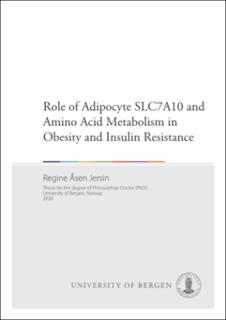Role of Adipocyte SLC7A10 and Amino Acid Metabolism in Obesity and Insulin Resistance
Doctoral thesis
Permanent lenke
https://hdl.handle.net/11250/2836255Utgivelsesdato
2020-12-18Metadata
Vis full innførselSamlinger
Sammendrag
Obesity is a rising global concern, associated with increased risk of developing metabolic syndrome, insulin resistance and type 2 diabetes. Chronic availability of excess nutrients may promote adipocyte dysfunction, especially in genetically susceptible individuals. Adipocyte amino acid transporter SLC7A10 and branched chain amino acid (BCAA) metabolism has recently been strongly associated with obesity and related disease, and dissection of the underlying molecular mechanisms may provide novel therapeutic targets.
The aim of the present study was to uncover novel mechanisms linking adipocyte SLC7A10, BCAA uptake and catabolism, and 3-hydroxyisobutyric acid (3-HIB) release to adiposity, insulin resistance and T2D.
In Paper 1, we performed a global transcriptome screen of adipose tissue in the context of obesity and insulin resistance, and identified SLC7A10 as a novel candidate gene in the regulation of adipocyte metabolism. We overfed Slc7a10 WT and loss-of-function mutant zebrafish, resulting in visceral adipocyte hypertrophy and higher weight gain for the mutants. Inhibition of SLC7A10 in adipocytes in vitro caused reduced serine uptake, total glutathione levels, insulin-dependent glucose uptake and mitochondrial respiratory capacity, while promoting increased ROS generation and lipid accumulation. Conversely, SLC7A10 overexpression showed the opposite effects on mitochondrial respiration and ROS compared to inhibition.
In Paper 2, we found that BCAA consumption and catabolism is increased during adipogenesis of human as well as brown and white mouse adipocytes in vitro. Knockdown of the 3-HIB generating enzyme HIBCH reduced adipocyte lipid storage and 3-HIB release. 3-HIB treatment affected respiration and ROS generation in opposite directions in white and brown mouse adipocytes.
In Paper 3, we performed a gene set enrichment analysis (GSEA) of RNA-sequencing data from SLC7A10 impaired human primary adipocytes, and found increased expression of genes related to lipid metabolism, TCA cycle and amino acid catabolism. Upon SLC7A10 inhibition, adipocytes showed increased uptake of BCAAs, aspartate, glutamate, and increased efflux of 3-HIB.
Overall, we have identified SLC7A10 and 3-HIB as regulators of adipocyte metabolism. Our work points to activation of adipocyte SLC7A10 as a potential preventive and/or therapeutic strategy for metabolic diseases, and implicates 3-HIB as a strong marker reflective of increased lipid accumulation, obesity and comorbidities.
Består av
Paper I: Jersin, Regine Å., Divya Sri Priyanka Tallapragada, André Madsen, Linn Skartveit, Even Fjære, Adrian McCann, Laurence Dyer et al. "Role of the neutral amino acid transporter SLC7A10 in adipocyte lipid storage, obesity, and insulin resistance." Diabetes 70, no. 3 (2021): 680-695. The article is available at: https://hdl.handle.net/11250/2761061Paper II: Nilsen, Mona S., Regine Å. Jersin, Arve Ulvik, André Madsen, Adrian McCann, Per-Arne Svensson, Maria K. Svensson et al. "3-Hydroxyisobutyrate, a strong marker of insulin resistance in type 2 diabetes and obesity that modulates white and brown adipocyte metabolism." Diabetes 69, no. 9 (2020): 1903-1916. The article is not available in BORA due to publisher restrictions. The published version is available at: https://doi.org/10.2337/db19-1174
Paper III: Jersin, Regine Å., Divya Sri Priyanka Tallapragada, Linn Skartveit, Sindre Lee-Ødegård, Christian Drevon, Adrian McCann, Melina Claussnitzer, Gunnar Mellgren, Simon N. Dankel. "Impaired adipocyte SLC7A10 function promotes lipid storage in association with altered BCAA metabolism and TCA cycle activity in insulin resistance.". The article is not available in BORA.
